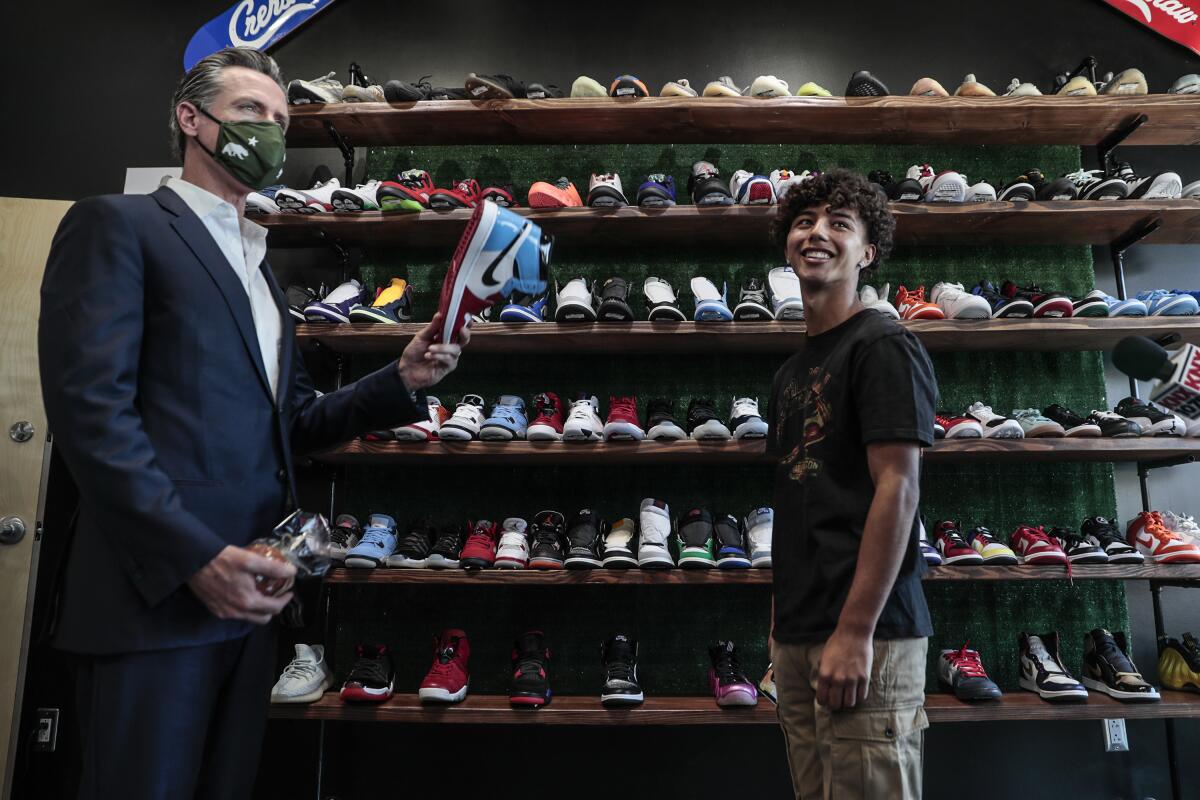How California reopening and COVID declining could spell trouble for Newsom recall effort

- Share via
SACRAMENTO — With the spread of COVID-19 plummeting in California, triggering reopenings across the state after a devastating year of lockdowns, the campaign to recall Gov. Gavin Newsom from office could lose one of its strongest selling points by the time voters are asked whether to remove him this fall.
Recall organizers remain confident that animosity will continue to linger over past school closures, job losses and the billions of dollars the state paid out to fraudulent unemployment claims during the pandemic, along with Newsom’s missteps, such as attending a lobbyist’s birthday party at Napa Valley’s French Laundry restaurant after asking Californians to refrain from similar gatherings.
But other Newsom critics say the recall campaign must tap into discontent over homelessness, sky-high housing costs and other central issues beyond the pandemic if the effort hopes to succeed.
“People want to get out and do things they haven’t done for a year and a half, so I think the challenge is getting their attention on issues that are not related to the pandemic,” said Republican political consultant Tim Rosales, who is not affiliated with the recall campaign. “The question is: Will people be thinking about that stuff again or will they say, ‘Hey look, I just want to get back to my life.’?”
Rosales pointed out that the Democratic governor’s political fortunes could rise or fall over the next several months, but Newsom’s prospects appear bright at the moment. California has the lowest COVID-19 positivity rates in the nation, driven in large measure by high vaccination rates and a state budget windfall that could top $30 billion by next summer. The governor has also vowed to reopen California’s economy by mid-June.
But that could change in an instant if the state sees another surge in virus cases, as other states and countries, including India, have experienced, or if the lives of Californians are upended by more familiar threats — wildfire and drought.
Rosales said that uncertainty also hamstrings Newsom’s challengers, including one the consultant worked for until recently — Republican businessman John Cox of Rancho Santa Fe, whom Newsom trounced in the 2018 governor’s race.
“There could be other issues that become top of mind and important to people that aren’t quite there yet,” Rosales said. “When ballots go out, what will people care about? Right now, there’s not an answer.”
In recent weeks, Newsom has aggressively criticized the recall effort as a sinister attack led by loyal supporters of former President Trump and far-right groups, and has listed at his events ways in which California is “roaring back,” noting that in February more than 40% of new jobs created in the U.S. were in this state.
“The state is recovering. The state is back on its feet,” Newsom said after receiving the endorsement of the California Professional Firefighters on Tuesday. “Our kids are increasingly back in in-person instruction. We have the lowest positivity and case rates in America. We’re extinguishing not just wildfires, but this disease.”
Though recent opinion polls show that Newsom’s job approval rating plunged after the COVID-19 surge at the end of 2020, the deadliest period California has seen during the pandemic, voter opinions were almost evenly split on the Democratic governor. Only about a third of those polled supported recalling Newsom — with the vast majority of those being Republican.
Mark DiCamillo, survey director of UC Berkeley’s Institute of Governmental Studies, said that in a state as left-leaning as California, proponents of the recall need to win over independents and moderates. That will be a tough task given the massive budget surplus that landed in Newsom’s lap, as well as the additional cash infusion of $26 billion under the federal COVID-19 relief bill signed into law by President Biden.
“When you don’t have money, when you’re starting to cut into popular programs, that’s usually when your job rating starts to tank,” DiCamillio said. “Newsom is in this really fortunate position, even if it’s a temporary one.”
At the very least, California’s economic recovery is expected to be robust in 2021, and unemployment is expected to steadily decline, according to a forecast released by the UCLA Anderson School of Management in March. Economist Jerry Nickelsburg, who directs the forecast, said he expects the state’s recovery to outpace the rest of the nation, driven in large part by growth in technology, manufacturing and construction.
“All of this assumes that we don’t have another [COVID-19] wave come roaring back,” Nickelsburg said.
But strong economic growth won’t be enough to help Newsom avoid criticism over his job performance in other areas ahead of a recall election. In September, a majority of California voters polled by the UC Berkeley Institute of Governmental Studies felt that Newsom was doing a poor job handling the state’s homelessness crisis, and nearly a majority were also sour on how he was addressing the state’s exorbitant housing costs.
But one of the biggest threats to Newsom come the fall may be public school closures during the pandemic, which had a negative effect on the quality of education for millions of California children. If students are not back in schools in the next academic year, that might stir up major political trouble for Newsom, DiCamillo said.
“He needs to get that squared away right now,” he said.
A recent poll by the Public Policy Institute of California found that a vast majority of California adults and public school parents believe their children have fallen behind academically. Still, almost two-thirds of public school parents said they approved of how Newsom is handling the state’s K-12 public education system.
David Gilliard, a veteran Republican consultant who is working on the recall campaign and helped place the successful 2003 recall of Democratic Gov. Gray Davis on the ballot, said governors in other states managed to open schools much faster than California. The resentment over the educational consequences crosses party lines and will provide ample fuel for the recall effort once it heats up, he said.
“Even if they’re back at school in the fall, they’re going to be a year behind,” Gilliard said. “A lot of kids, especially kids that are in some of the lower socioeconomic areas, didn’t maybe have the ability to hire tutors or have all the equipment they needed electronically or ability to get on the internet.”
Gilliard said that, along with Newsom’s handling of other quality-of-life issues such as homelessness and housing affordability, one of the governor’s biggest vulnerabilities is that he comes across to some as “arrogant and above everybody else.”
Newsom made his fortune in the hospitality business as an owner of several wineries and restaurants. The governor and his wife paid $3.7 million in 2019 for their home outside of Sacramento. Their children, who attend private school, went back to in-classroom learning at a time when most public schools remained closed.
Gilliard said Newsom’s image was cemented by his visit to the posh French Laundry, when he and his wife, Jennifer Siebel Newsom, attended the birthday party of friend and Sacramento lobbyist Jason Kinney as the governor was urging Californians to avoid gatherings.
“When we do polling, that comes up almost more than anything else,” Gilliard said. “It’s like, ‘Yeah, he told us we couldn’t do it — and he did it.’ That really resonates with voters, and it makes them angry.”
What may be less of a factor in the decision-making of voters are the issues listed on the petition to recall Newsom from office, a campaign that began months before the COVID-19 pandemic overwhelmed daily life in California.
The petition called for Newsom’s ouster over California’s high taxes and criticized him for protecting immigrants who enter the country illegally. It also took Newsom to task for halting executions and rationing water use.
Randy Economy, spokesman for Recall Gavin 2020, the organization leading the effort to oust Newsom, noted that the word “COVID-19” never appeared on the petition to recall the governor. It was the Newsom administration’s other policies that stoked anger and resentment among voters, and his response to the pandemic solidified those feelings, Economy said.
“We don’t need to remind the average Californian on what he’s done for the past two years since he’s been in office,” Economy said. “All they need to do is look inside their families, look inside their wallets and look inside their mom-and-pop businesses and they’ll realize that they’ve suffered under this governor, and a lot of states didn’t suffer like this.”
UC San Diego political scientist Thad Kousser said momentum during the Newsom recall drive peaked in the winter, when the spread of the virus was surging, businesses were shut down and stories about Newsom’s French Laundry episode dominated the news.
But things have changed since then, he said.
“The day that it qualifies, we have the lowest COVID rates in the lower 48 states, we have tens of billions of dollars in budget surplus for the governor and the Legislature to hand out, and the economy is reopening and schools are back in session.”
More to Read
Sign up for Essential California
The most important California stories and recommendations in your inbox every morning.
You may occasionally receive promotional content from the Los Angeles Times.














